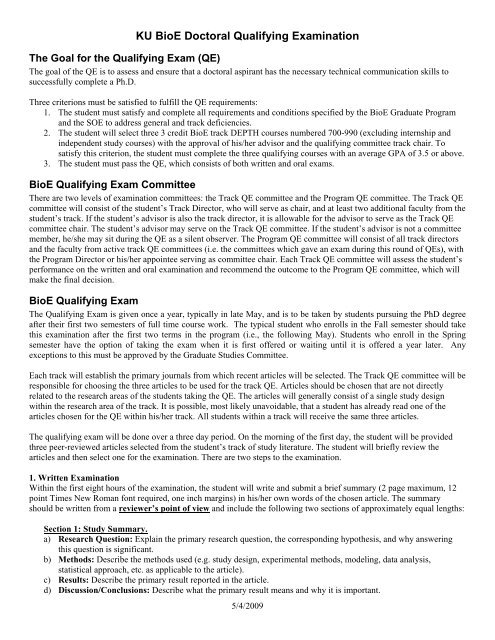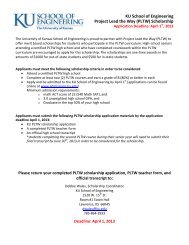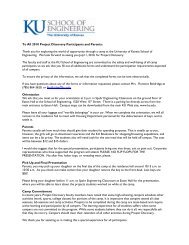Ph.D. Qualifying Exam
Ph.D. Qualifying Exam
Ph.D. Qualifying Exam
Create successful ePaper yourself
Turn your PDF publications into a flip-book with our unique Google optimized e-Paper software.
KU BioE Doctoral <strong>Qualifying</strong> <strong>Exam</strong>inationThe Goal for the <strong>Qualifying</strong> <strong>Exam</strong> (QE)The goal of the QE is to assess and ensure that a doctoral aspirant has the necessary technical communication skills tosuccessfully complete a <strong>Ph</strong>.D.Three criterions must be satisfied to fulfill the QE requirements:1. The student must satisfy and complete all requirements and conditions specified by the BioE Graduate Programand the SOE to address general and track deficiencies.2. The student will select three 3 credit BioE track DEPTH courses numbered 700-990 (excluding internship andindependent study courses) with the approval of his/her advisor and the qualifying committee track chair. Tosatisfy this criterion, the student must complete the three qualifying courses with an average GPA of 3.5 or above.3. The student must pass the QE, which consists of both written and oral exams.BioE <strong>Qualifying</strong> <strong>Exam</strong> CommitteeThere are two levels of examination committees: the Track QE committee and the Program QE committee. The Track QEcommittee will consist of the student’s Track Director, who will serve as chair, and at least two additional faculty from thestudent’s track. If the student’s advisor is also the track director, it is allowable for the advisor to serve as the Track QEcommittee chair. The student’s advisor may serve on the Track QE committee. If the student’s advisor is not a committeemember, he/she may sit during the QE as a silent observer. The Program QE committee will consist of all track directorsand the faculty from active track QE committees (i.e. the committees which gave an exam during this round of QEs), withthe Program Director or his/her appointee serving as committee chair. Each Track QE committee will assess the student’sperformance on the written and oral examination and recommend the outcome to the Program QE committee, which willmake the final decision.BioE <strong>Qualifying</strong> <strong>Exam</strong>The <strong>Qualifying</strong> <strong>Exam</strong> is given once a year, typically in late May, and is to be taken by students pursuing the <strong>Ph</strong>D degreeafter their first two semesters of full time course work. The typical student who enrolls in the Fall semester should takethis examination after the first two terms in the program (i.e., the following May). Students who enroll in the Springsemester have the option of taking the exam when it is first offered or waiting until it is offered a year later. Anyexceptions to this must be approved by the Graduate Studies Committee.Each track will establish the primary journals from which recent articles will be selected. The Track QE committee will beresponsible for choosing the three articles to be used for the track QE. Articles should be chosen that are not directlyrelated to the research areas of the students taking the QE. The articles will generally consist of a single study designwithin the research area of the track. It is possible, most likely unavoidable, that a student has already read one of thearticles chosen for the QE within his/her track. All students within a track will receive the same three articles.The qualifying exam will be done over a three day period. On the morning of the first day, the student will be providedthree peer-reviewed articles selected from the student’s track of study literature. The student will briefly review thearticles and then select one for the examination. There are two steps to the examination.1. Written <strong>Exam</strong>inationWithin the first eight hours of the examination, the student will write and submit a brief summary (2 page maximum, 12point Times New Roman font required, one inch margins) in his/her own words of the chosen article. The summaryshould be written from a reviewer’s point of view and include the following two sections of approximately equal lengths:Section 1: Study Summary.a) Research Question: Explain the primary research question, the corresponding hypothesis, and why answeringthis question is significant.b) Methods: Describe the methods used (e.g. study design, experimental methods, modeling, data analysis,statistical approach, etc. as applicable to the article).c) Results: Describe the primary result reported in the article.d) Discussion/Conclusions: Describe what the primary result means and why it is important.5/4/2009
Section 2: Study Assessment and Application.a) Study Limitations and Future Studies: Describe one study limitation and one “next step” that you believeshould be taken to further this line of research.b) Assessment: Assess the strengths and weaknesses of the article.c) Application: Describe how this article is related to your research area, and/or how the knowledge produced mayaffect your dissertation research, and/or how it relates to your personal experiences.The student will be allowed one dictionary (hardcopy). No other outside help or resources will be allowed.A computer with word processing will be provided. The written examination will last 5 hours or less.2. Oral <strong>Exam</strong>inationWithin the next three days of the examination, the student will prepare a formal (e.g. PowerPoint) presentation of thearticle, describing it as if he/she were presenting an article review at a scientific conference. The oral presentation outlineshould address the same two sections and the points required in the required written summary.The student is not allowed to seek help from anyone, including other graduate students, in preparation of the oralexam. The student may utilize resources such as published manuscripts, textbooks, and references as needed toclarify the manuscript content.This is not an examination of research methods. It is also not an examination of the student’s ability to assimilate a broadresearch topic. This is an examination of the student’s ability to effectively communicate and evaluate the informationcontained within the chosen article. Therefore, no other articles should be referred to during the presentation. The oralpresentation will last 20 minutes or less (10-12 minutes expected). The presentation, including examination committees’questions on the article’s content, will last 60 minutes or less (30 minutes expected).<strong>Qualifying</strong> <strong>Exam</strong> DecisionThe decision to pass or fail a student on the <strong>Qualifying</strong> <strong>Exam</strong>ination is based on the overall performance of both thewritten and oral examinations. The decision is made by the full examination committee at a special faculty meeting toassign each candidate to one of four categories:(1) passing (unconditionally),(2) conditional pass (if the specified requirements are met, this becomes a pass),(3) failing, but with permission to retake the test the following year (and possibly, conditional on meeting specifiedrequirements), and(4) failing and not permitted to retake the exam.The faculty decision is conveyed to the student in writing after the review process. Appeals of this decision must beinitiated with the Program Director and may involve a meeting of the full <strong>Exam</strong>ination Committee to hear and deliberatethe case. Written examinations will not be returned to the student, except possibly in the case of appeal by the student tothe <strong>Exam</strong>ination Committee. A student is allowed no more than two opportunities to take the qualifying examination andis admitted to <strong>Ph</strong>D candidacy only after he/she has passed this exam.A student who passes the <strong>Qualifying</strong> <strong>Exam</strong>ination and then decides to do his/her research in a different track will not berequired to repeat the <strong>Qualifying</strong> <strong>Exam</strong>ination in the new track.5/4/2009








